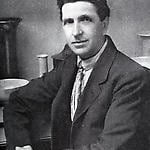

In 1901 William Howson Taylor (1876-1935; pictured), having graduated from the Birmingham School of Art, began production at the Ruskin Pottery (founded with his father in 1898) in West Smethwick, England. He used a combination of local clay and other elements to create high-fired pieces inspired by the Sung and Ming periods. Taylor was primarily interested in glaze effects and specialized in expertly produced variations upon four principal effects all of which had been pioneered in an earlier decade by the leaders of the French Ceramics Revolution: crystalline, flambé, luster, and souffle. He destroyed all of his notes and recipes shortly before his death. The flambé glaze, which includes sang de boeuf, is considered by some collectors to be Ruskin's best. Flambé techniques, which require firing at a very high temperature, were developed in France in homage to effects seen by the French on Asian ceramics. Ruskin's flambé pieces were fired in the famous "red kiln". Only a few trusted employees were allowed to supervise the firings and visitors were never allowed to see the kiln. In addition to the red "sang de boeuf" glaze other high-fired colors included purples, blues, ivory, greens and browns. There were effects, including snakeskin, crackling, veining, mottling and fissures.
Lustre glazes were first produced at the factory in 1905. They had been widely produced in Europe during the late 19th century and Howson Taylor drew inspiration from these precedents. While first associated with Islamic ceramics, lusters had been reintroduced in France circa 1885, when Clément Massier devoted himself to rediscovering them.
Soufflé glazes were the first to be experimented with in the early days of the pottery and continued to be produced until the factory closed. The mottled effects of the soufflé glazes may have been produced by spraying vessels with colored powders.